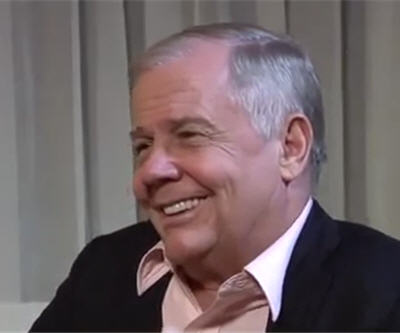
Gold is trading back below $1,600 an ounce after falling almost $30 on Friday and is now showing a loss for 2012.
Jim Rogers, the legendary commodity investor tells CNBC the 20% pullback in the price of gold from record highs in August last year may not have run its course:
“I’ve actually owned gold for longer than 11 years. I’m not buying now. Gold went up 11 years in a row, which is extremely unusual for any asset. I don’t know of any asset in history that’s gone up 11 years in a row without a correction.
“Corrections are normal and are the way things should work, the way things do work. Having said that, I don’t know when the correction will stop. It’s normal in my experience for corrections to go down 30 or 40 percent. It’s just the way markets work.
“Gold has not gone down that much. It’s only gone down that much once in the past 11 years, and even then it ended the year up. I’m not buying gold at the moment. If it goes down a lot, I hope I’m smart enough to buy a lot more. I’m certainly not selling my gold, because I suspect gold will be much, much, much higher over the next decade.
Volatility in the gold price has increased dramatically.
At the start of April for instance gold dropped some $60 an ounce in a single session when Fed minutes appeared to indicate QE3 was off the table and its policy of zero interest rates may be coming to an end sooner than previously thought.
The same thing happened on June 7 when gold dropped $50 to under $1,600 an ounce in a couple of hours after Bernanke delivered “anti-climactic” testimony to the US Congress.
That was not the first time traders got cold feet after breaking an important psychological level. A similar pattern was followed in the days after gold futures hit a record high above $1,900 an ounce in August. The yellow metal slid for two days after hitting the record, losing $105 or 5.6% in value in a single day.
In 2011 trading in gold was the most volatile since 1980 with the gap between the year’s highs and lows coming in at close to $600 an ounce or a 32% range.
In 1980 the spread was even greater at more than 40% and followed the 21 January 1980 record of $850 a ounce set after a spike in oil prices following the Iranian revolution and Russia’s invasion of Afghanistan.
At the time gold also fell precipitously after setting the record – within two days it fell back to under $700 starting a bear market that lasted almost three decades.
Gold breached $850 again at the start of 2008, but in inflation adjusted terms the 1980 price is still the highest ever – gold would have to hit some $2,400 an ounce to set a record in today’s money.